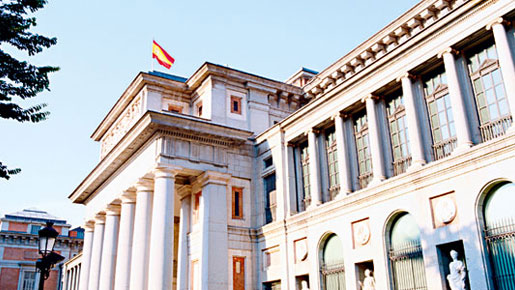

What really makes Madrid special, however, is its people: madrilenos are indefatigable when it comes to both work and play; they’ll have dinner at midnight, followed by drinks and dancing until the early hours, but
be at their desks at 9am, untarnished by the night’s revels. With the locals providing such an example, it’s hard not to get caught up in the open, fun-loving spirit of the city, even if your timetable (or temperament) won’t allow for such excesses.
While Madrid by night is one big party, by day, culture is very definitely king. The city has an excellent transport system and an army of friendly taxi drivers, but when the sun is shining, there’s no better way to explore the centre than on foot. The Puerta del Sol is known as the naval of Madrid, not only for its central location, but also for the place it holds in the hearts of madrilenos: the square is the location of the famous bell whose toll marks the start of the New Year; as well as the statue of the bear with a madrone tree, and the Tio Pepe sign, the old and new symbols of the city.
A short walk to the west is the imposing Plaza Mayor, an 18th century portico-lined square whose buildings boast painted facades and 237 balconies. Over the centuries Plaza Mayor has been used for football matches, bull fights and even public executions, but is now home to less bloody pursuits and is a major attraction for visitors to the city. At Christmas time the square becomes an enormous festive market, filled with families in fancy dress shopping for decorations, gifts and artisan food products.
Beyond Plaza Mayor is the Palacio Real (+34 91 454 88 00; patrimonionacional.es), the official Madrid residence of King Juan Carlos of Spain. The royal family don’t actually live at the palace, but it is still used for state
functions, as well as being open to the public. There has been a fort on the site since the 10th century, but the present building dates back to the 1750s and is well worth visiting for its opulent interiors and impressive art collection. Adjacent to the palace are the Sabatini Gardens, whose walkways and fountains provide a peaceful location from which to view the palace’s north facade.
On the other side of the Puerta del Sol lies the museum quarter, home to Madrid’s golden triangle of art, the Museo del Prado, the Museo Reina Sofia and the Museo Thyssen-Bornemisza, three of Spain’s most prestigious galleries. The Museo del Prado (+34 91 330 2800; museodelprado.es) houses one of the most important collections of European art in the world, comprising almost 8,000 paintings from the 12th to the 19th centuries, as well as many thousands of sculptures, prints and drawings. To help visitors navigate the huge collection, the museum’s curators have put together useful routes for visits of one, two or three hours that take in some of the Prado’s best known masterpieces, including Velquez’s Las Meninas, El Greco’s The Nobleman with his Hand on his Chest and Goya’s The 3rd of May 1808 in Madrid: the Executions on Principe Pio Hill.
The Museo Reina Sofia (+34 91 774 10 00; museoreinasofia.es) takes over where the Prado leaves off, presenting 20th century art, mainly by Spanish artists. There are fine collections of the works of Salvador Dali, Juan Gris, Juan Miru, and, of course, Pablo Picasso. The museum’s trophy piece is Picasso’s Guernica, his response to the horrific bombing of the northern city during the Spanish Civil War; the enormous painting now sits in a purpose-built gallery.
The Museo Thyssen-Bornemisza (+34 91 369 01 51; museothyssen.org), completes the golden triangle. Its collection, put together in the first half of the 20th century by Baron Heinrich Thyssen-Bornemisza and
extended by his son, features European and American masterpieces spanning eight centuries, including works by Titian, Caravaggio, Claude Monet, Vincent Van Gogh, Piet Mondrian and Edward Hopper. The Thyssen is
a unique opportunity to see work from periods of art history not covered by Madrid’s state-owned galleries.
Those seeking less high-brow diversions will find no shortage of enjoyment in Madrid’s shopping scene. The boulevards of the chic district of Salamanca are home to international luxury brands such as Gucci, Louis Vuitton and Valentino, as well as Spanish designers including Adolfo Dominguez and Victorio & Lucchino. Calle de Princesa, which runs northwest from Plaza de Espana, is another favourite for big brand high street shopping.
At the opposite end of the luxury spectrum is El Rastro, the city’s sprawling open air flea market, which takes place every Sunday and on public holidays in the streets south of La Latina metro station. Get there early to avoid the crowds and find bargains at stalls selling everything from second-hand clothes, rare books, prints and bric-a-brac. Antique shops in the area are also open on Sundays.
For funky, independent fashion and jewellery boutiques, Chueca and neighbouring Fuencarral are where to go. You’ll find the streets buzzing, with a cool, young crowd dressed in the latest quirky styles.
These districts are also home to some charming cafes. Cafe Comercial (+34 915 215 655; Glorieta de Bilbao, 7) is one of the city’s oldest, dating back to 1887. Stop in at the old-fashioned, ornate dining room for a coffee or snack during the day, or pass by in the evening for a cana (small beer) before heading to the authentic and hectic Casa Maravillas (+34 914 488 259; Calle de Manuela Malasana, 13) in nearby Malasana to sample its varied tapas menu.
The streets around the very central Plaza de Santa Ana offer further nightlife and dining options, including the stunning roof terrace of the trendy Me Madrid hotel (+34 902 14 44 40; memadrid.com). With the city laid out before you, there’s no better place to sip a cocktail and think about where the spirit of Madrid will take you next.

